Tokyo top tourist attractions city travel sightseeting map
City centre free English travel guide - Must-see sights location, best destinations to visit, metro & districts - Tokyo top tourist attractions map
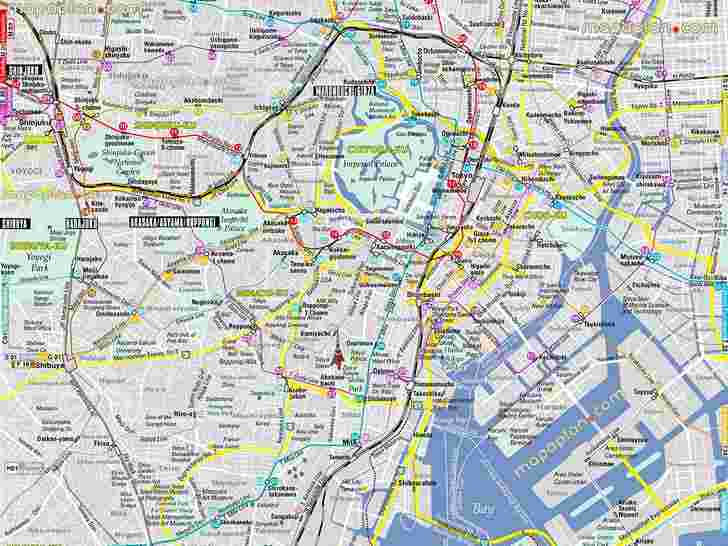
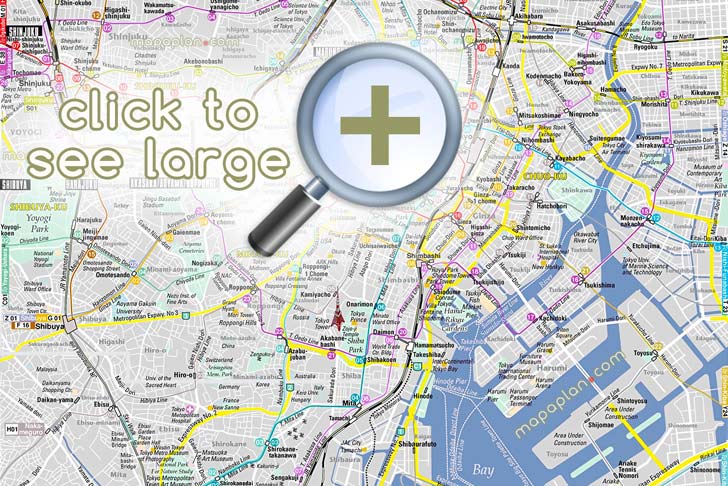
Maps of best attractions in Tokyo, Japan
Tokyo maps will guide you to the best destinations in this energetic city. Tokyo is notoriously hard for visitors to find their way around, due to the scarcity of street names and the complex numbering system for buildings. The Tokyo top sights, plus hotels, restaurants, and many of the city’s key landmarks are plotted on our detailed city plans. Public transportation points (metro subway & trains) are also marked, and indicated by the symbols listed in the maps key. Below you can also find detailed maps of Tokyo’s individual districts, including Shinjuku, Roppongi, Ueno, Hibiya and other areas you’ll probably visit. Armed with these maps, you should be able to find the accurate location of must-see places. If you are either a first-time tourist looking for the top ten must-do sights or if you are returning to Tokyo to discover something new - all you need to ensure an enjoyable trip is some advance planning using our detailed diagrams. Our maps will help you find the detailed locations of the must-go areas including Imperial Palace Grounds in Chiyoda, Senso-ji Temple in Asakusa, Sumida River, Edo-Tokyo Museum in Ryogoku, Tsukiji Fish Market, Ueno Park Zoo, National Museum, Koishikawa Korakuen Garden, Meiji Shrine in Shibuya, Yanaka Cemetery, Odaiba Island, Shinjuku Gyoen Garden, Harajuku, Oriental Bazaar, Disneyland & DisneySea, Sky Tree, Roppongi Hills, Yoyogi Park, Zojoji Temple, Hama Rikyu Garden in Shiodome, Yasukuni Shrine, Shinjuku Golden Gai, Metropolitan Government Building, Kabukicho red-light district, National Museum of Nature and Science, Rainbow Bridge, Edo Castle, Takeshita Dori Street, Kanda Myojin Shrine, Sengakuji Temple, Joypolis, Big Sight, Tokyo Dome City Attractions in Bunkyo, Happo-en Garden, Tsukishima, Rikugien Garden - just click on a selected map to access a high resolution version that can be downloaded and printed; or saved onto your mobile device.
Interactive tourist information new map showing directions to points of interest in downtown Tokyo including iconic places, major landmarks, districts, bullet main rail station, Senso-ji Temple, Koishikawa Korakuen Garden, Dome, Tsukiji Fish Market, expressways, Chiyada, Shinjuku, Shibuya, Yoyogi, Asakusa - Tokyo printable sightseeing map
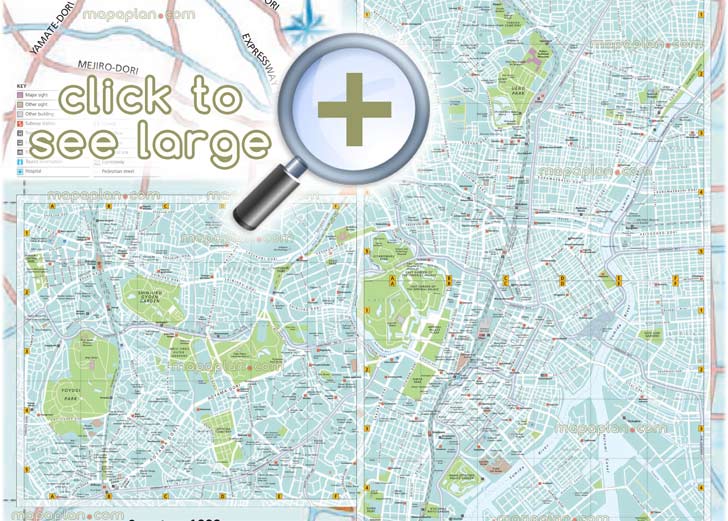
You can view, download or print a full, high resolution (detailed, large) version of this image by clicking on the plan itself
Attractions & metro subway stations, railway train transit, JR, TOEI & Streetcar (Toden Arakawa tram tramway) lines - Public transport rail routes network official diagram (tube, monorail, overground rides) near the metropolitan area, Haneda & Narita International Airport Terminals - Tokyo detailed travel map
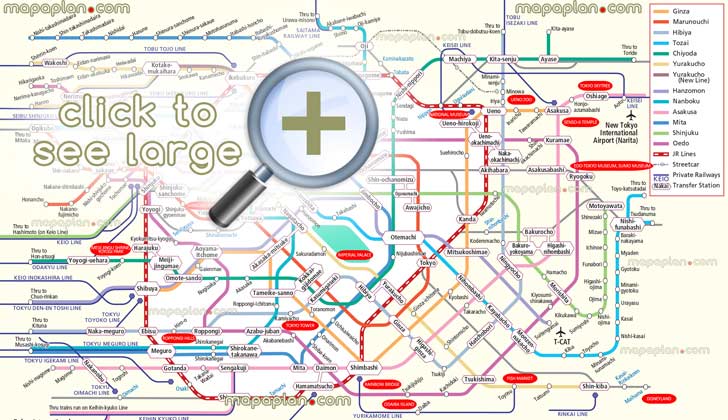
You can view, download or print a full, high resolution (detailed, large) version of this image by clicking on the plan itself
All districts & neighborhoods metro train stations navigation including Ginza, Hibiya, Akasaka, Nihonbashi, Shinjuku, Ueno, Shibuya, Yanaka, Roppongi, Harajuku, Aoyama, Asakusa, Akihabara, Odaiba Island, Shinagawa - Sky Tree, Yoyogi Park, Meiji Shrine Outer Garden, Imperial Palace East & Botanical Garden - Tokyo interesting places map
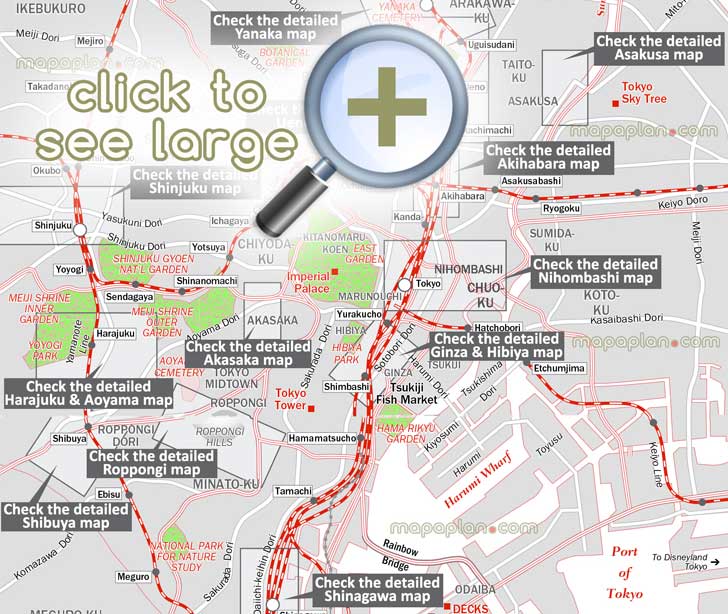
You can view, download or print a full, high resolution (detailed, large) version of this image by clicking on the plan itself
Tourist information center easy overview map with best landmarks, subway train stations, districts, hotel accommodation, museums, art galleries, theatres, department stores, shopping malls & centers showing Zojoji Temple, Kanda Myojin Shrine, Tokyo Tower, Meiji Shrine, Yoyogi Park, Akasaka Palace, Tsukiji Fish Market, Rikugien Garden - Tokyo landmarks map
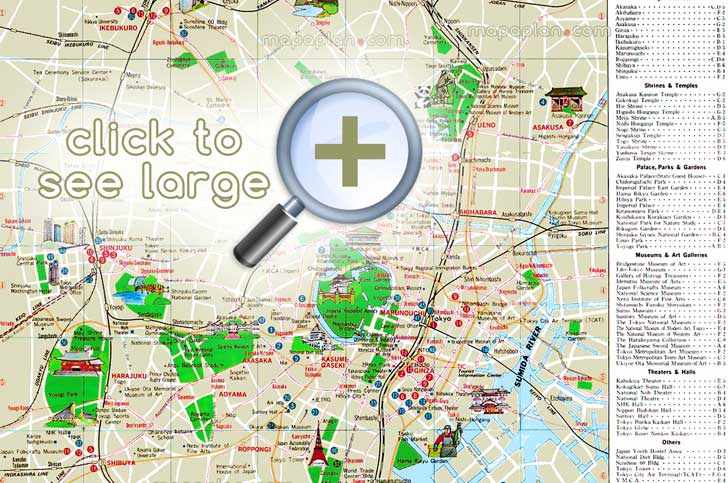
You can view, download or print a full, high resolution (detailed, large) version of this image by clicking on the plan itself
Virtual sightseeing plan of famous metropolitan area attractions & metro train stations showing what to see & where to go including historical old sites guide, museums, art galleries, exhibitions, great historic spots including Rikugien Garden, Sumida River, Yasukuni Shrine, Joypolis, Shinjuku Gyoen National Garden - Tokyo tourist guide map
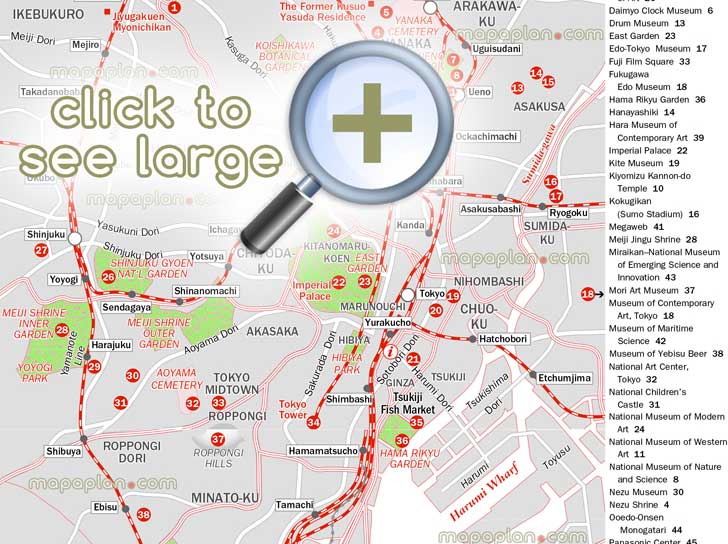
You can view, download or print a full, high resolution (detailed, large) version of this image by clicking on the plan itself
Skybus hop-on hop-off double decker open top red couch tour stops - Must-do places & central highlights with fun things to do with kids / children / family including Sky Tree Solamachi Mall & Sumida Aquarium, midtown, Roppongi Hills, Tower, Rainbow Bridge, Aqua City, Ginza, Ueno Zoo, Senso-ji - Tokyo map of things to do
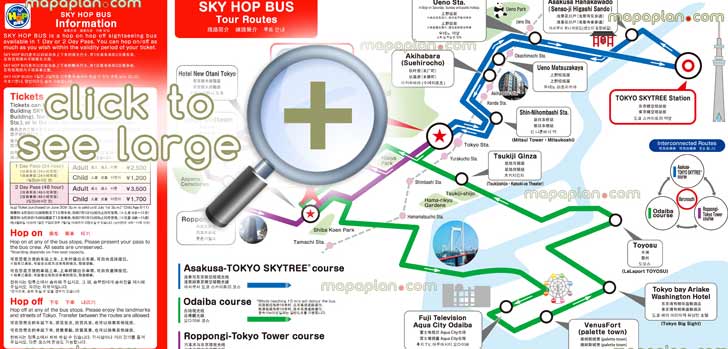
You can view, download or print a full, high resolution (detailed, large) version of this image by clicking on the plan itself
Imperial Palace gardens & Chiyoda 3d map in English showing Marunouchi & Ginza districts detailed road & street names plan with favourite points of interest including Kokyo Seimon main gate bridge, Hibiya Park, Tokyo metro train station, Otemachi, Yurakucho, Nagatacho, Akasaka, Kojimachi, Ichigaya, Shimbashi, hotels - Tokyo jpg full map
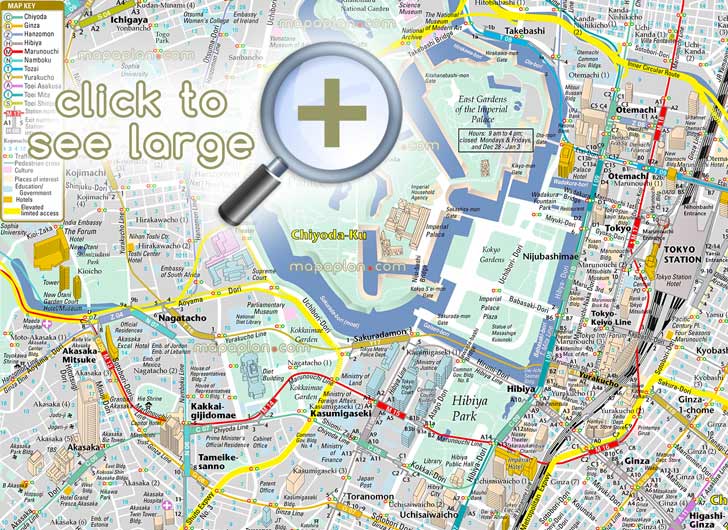
You can view, download or print a full, high resolution (detailed, large) version of this image by clicking on the plan itself
Shibuya metro train station, Harajuku, Aoyama, Roppongi & Akasaka districts - Bird's eye aerial graphical satellite view showing 3d buildings, public transportation stations with Meiji Jingu Shrine, Hall & Outer Gardens, Takeshita Dori Street, Yoyogi Park, cemetery, National Art Center, Midtown Tower - Tokyo free city highlights map
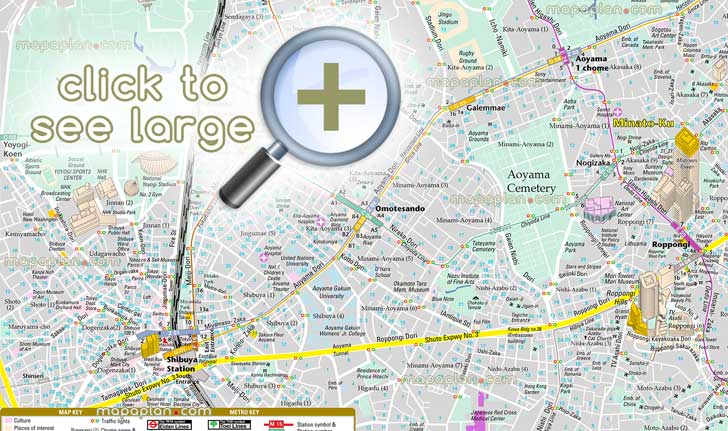
You can view, download or print a full, high resolution (detailed, large) version of this image by clicking on the plan itself
Shinjuku district metro station map of main interesting sites & travel hot spots worth visiting including Shinjuku Gyoen Garden & Central Park, Opera City, Japanese Sword Museum, Hyatt Regency hotel, Tochomae, Nishi-Shinjuku - Tokyo easy interactive map
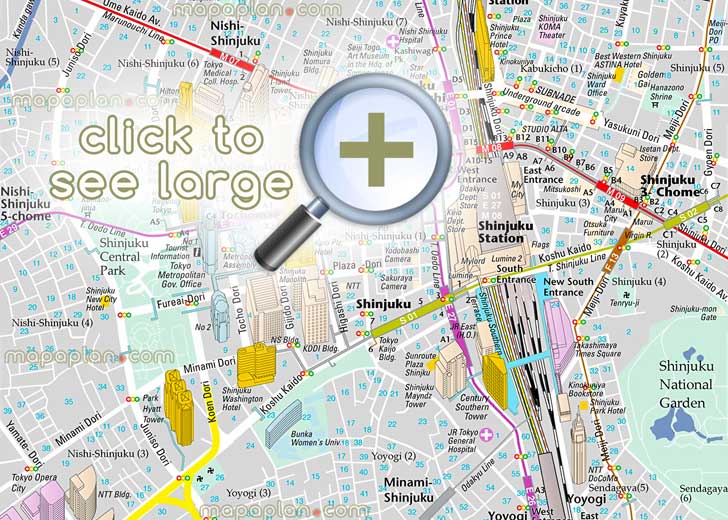
You can view, download or print a full, high resolution (detailed, large) version of this image by clicking on the plan itself
Asakusa metro train station & old town historic, religious & cultural sites including Senso-ji Temple monument, Five Storied Pagoda, Hozomon Gate, Asakusa-Jinja Shrine, Denbo-in, Hanakawado Park, AMUSE Museum, Asakusa Tourist Information Center, Sumida Park, Hanayashiki Amusement Park, Drum Museum - Tokyo offline urban map

You can view, download or print a full, high resolution (detailed, large) version of this image by clicking on the plan itself
Imperial Palace Grounds in Hibiya city centre - Visitors map showing Imperial Household Agency, Nijubashi, Budokan, Crafts Gallery, Science Museum, National Museum of Modern Art, Music Hall, Higashi Gyoen Garden, Fujimi-yagura, Imperial Plaza, Kudanshita, Jimbocho, Yurakucho Station - Tokyo main tourist attractions map
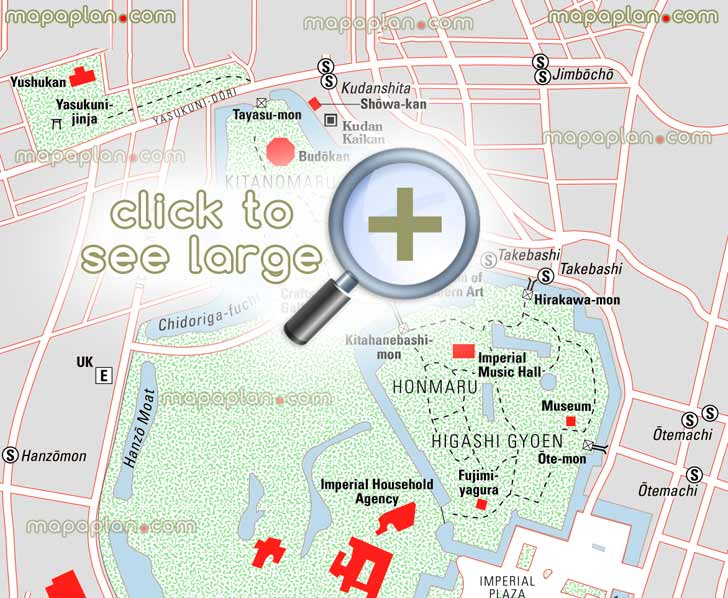
You can view, download or print a full, high resolution (detailed, large) version of this image by clicking on the plan itself
Ginza shopping area layout map with hotel accommodation, restaurants & teahouses - JNTO TIC (Japan National Tourist Organization Tourist Information Center), Tokyo Station, Kite Museum, National Film Centre, Idemitsu Museum of Arts, Daimaru Department Store, Gallery Natsuka, Central Wholesale Market - Tokyo online map
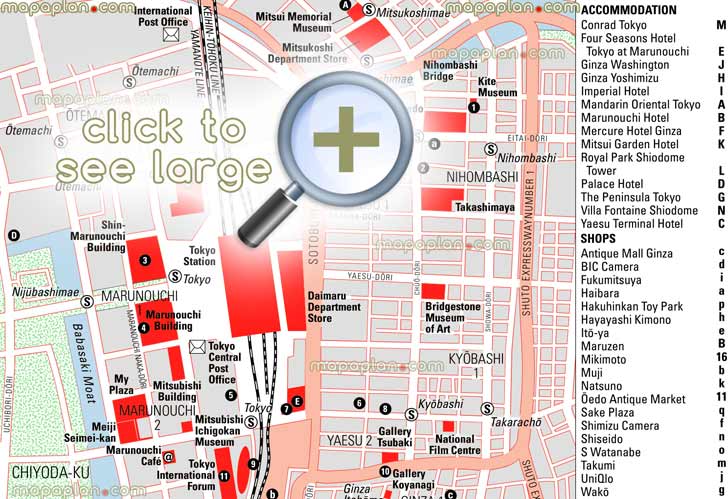
You can view, download or print a full, high resolution (detailed, large) version of this image by clicking on the plan itself
Kanda & Akihabara districts orientation map showing directions to local train / metro stations & Tokyo Dome City Attractions in Bunkyo, Science Museum, Baseball Museum - Tokyo simple map
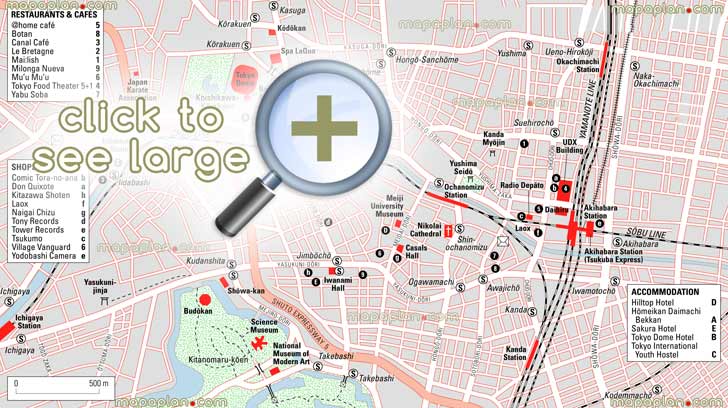
You can view, download or print a full, high resolution (detailed, large) version of this image by clicking on the plan itself
Ryogoku district & station location showing nearby landmarks including Edo-Tokyo Museum, Museum of Contemporary Art, National Sumo Stadion, Sumida-gawa River, Shuto Expressway - Tokyo downloadable map
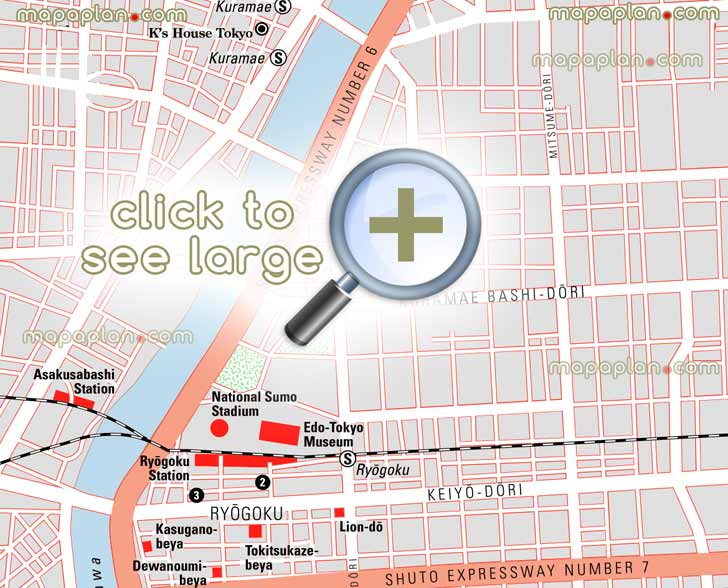
You can view, download or print a full, high resolution (detailed, large) version of this image by clicking on the plan itself
Akasaka & Roppongi Tokyo midtown detailed plan with Hie-Jinja shrine, Sacas, Hills, Tower, Akasaka Detached Palace (Geihinkan), Kimono Museum - Tokyo poster map
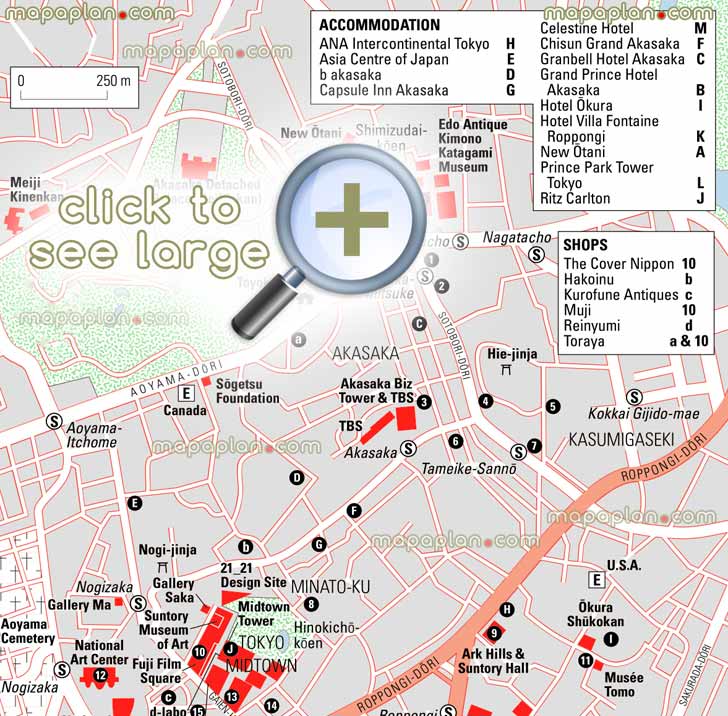
You can view, download or print a full, high resolution (detailed, large) version of this image by clicking on the plan itself
Roppongi Hills & Azabu Juban large scale map - How to get to clubs & nightlife entertainment, Mori Gardens - Tokyo location map
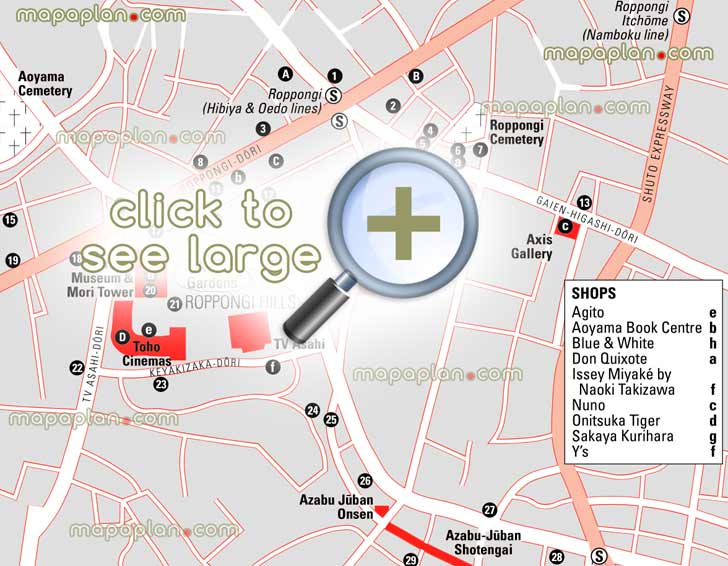
You can view, download or print a full, high resolution (detailed, large) version of this image by clicking on the plan itself
Asakusa & surrounding places to visit including Rox & Matsuya Department Stores, Senjo-ji Temple, Nakamise-Dori Street, Asakusa metro train station - Map of Tokyo tourist attractions
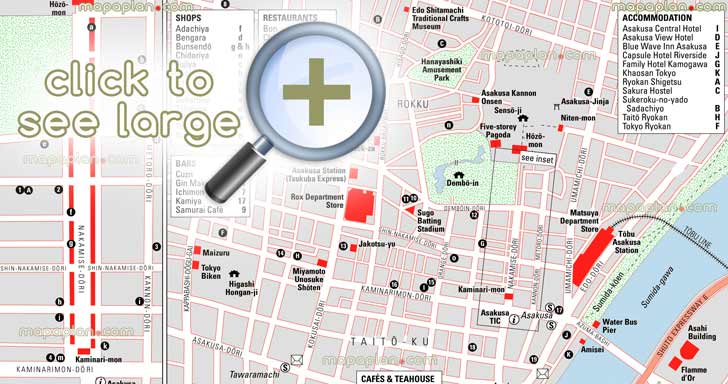
You can view, download or print a full, high resolution (detailed, large) version of this image by clicking on the plan itself
Ueno Park Zoo, metro / subway station - Tokyo National Museum, National Science Museum, National Museum of Western Art, Tokyo Metropolitan Art Museum, Shitamachi Museum, Yanaka Cemetery - Tokyo iconic tourist attractions map
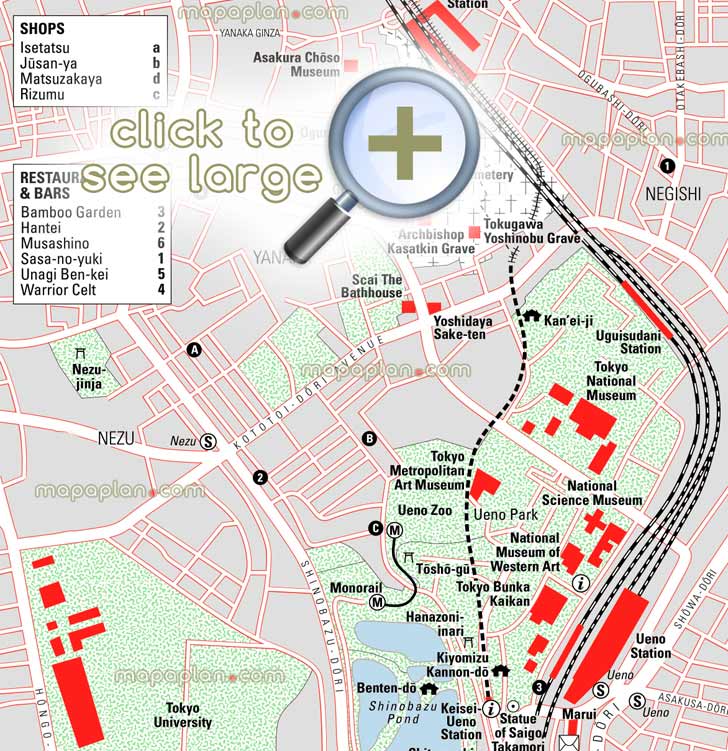
You can view, download or print a full, high resolution (detailed, large) version of this image by clicking on the plan itself
Ikebukuro district JR Station showing nearby uptown & northern Tokyo locations including Sunshine City shopping, Japan Traditional Craft Centre - Tokyo large scale map
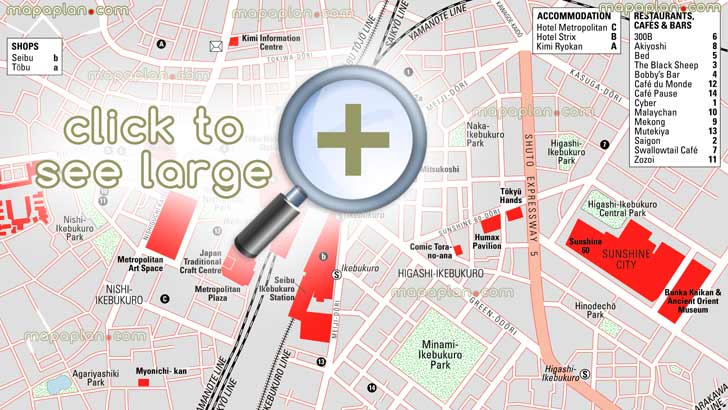
You can view, download or print a full, high resolution (detailed, large) version of this image by clicking on the plan itself
Shinjuku subway train station map showing Park Tower, Tokyo Opera City, Seiji Togo Memorial Sompo Japan Museum of Art, Metropolitan Government Building, Kabukicho red-light district nightclubs, top bars, good dining restaurants & cafes, budget hotels & cheap accommodation, shopping, Nichome - Tokyo top tourist attractions map
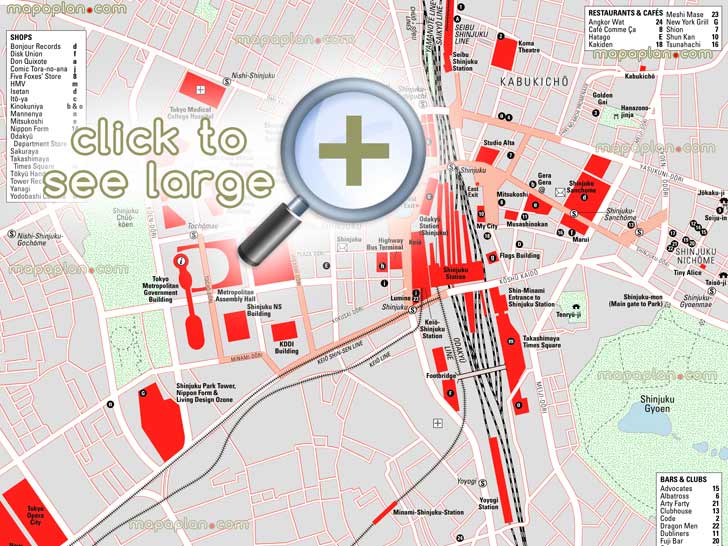
You can view, download or print a full, high resolution (detailed, large) version of this image by clicking on the plan itself
Harajuku metro station stop & Aoyama district map with nearby must-see places including Meiji-jingu Shrine Inner & Outer Garden, Yoyogi Koen Park, Shuto Expressway highway, shops, Yoyogi Park & station - Tokyo top tourist attractions map

You can view, download or print a full, high resolution (detailed, large) version of this image by clicking on the plan itself
Omotesando Hills metro train station & around map showing local area, A-Z list of shops, outlets, Harajuku, Shibuya, Minato - Tokyo top tourist attractions map
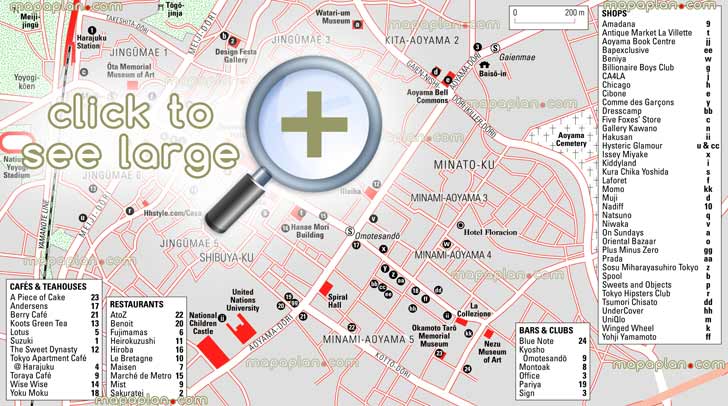
You can view, download or print a full, high resolution (detailed, large) version of this image by clicking on the plan itself
Shibuya Crossing map showing location of metro train station, Hachiko the Dog Statue station exit - Tokyo top tourist attractions map

You can view, download or print a full, high resolution (detailed, large) version of this image by clicking on the plan itself
Odaiba Island in Tokyo Bay monorail map with DiverCity Plaza, Gundam Front Tokyo & Gundam statue, Palette Town, Rainbow Bridge, Hama Rikyu Teien Garden in Shiodome, Panasonic Center Tokyo, Big Sight, Tsukishima, MeSci (Museum of Emerging Science and Innovation), bayside / seaside beach park, Tsukishima, Toyosu, Daiba station - Tokyo top tourist attractions map
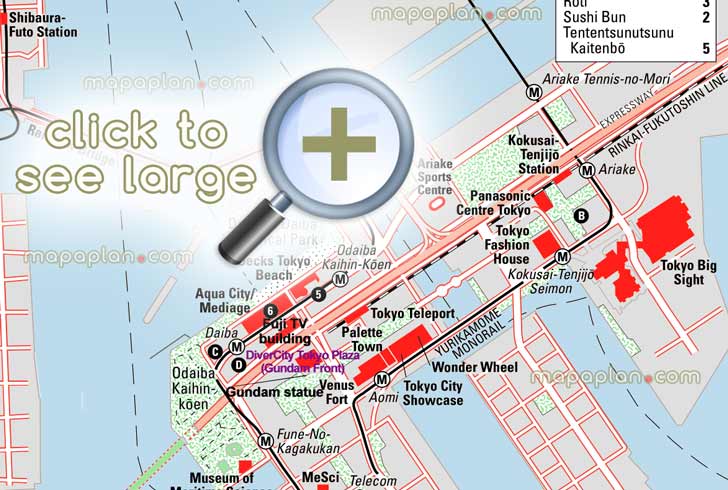
You can view, download or print a full, high resolution (detailed, large) version of this image by clicking on the plan itself
City center map with Chiyada Imperial Palace zone, distances to gates (Sakuradamon, Hanzomon, Otemon, Wadakura Mon), Plaza, Yurakucho metro train line station, Otemachi, Toranomon, Nagatacho, Hie Shrine, Ginza, Hibiya Park - Tokyo top tourist attractions map
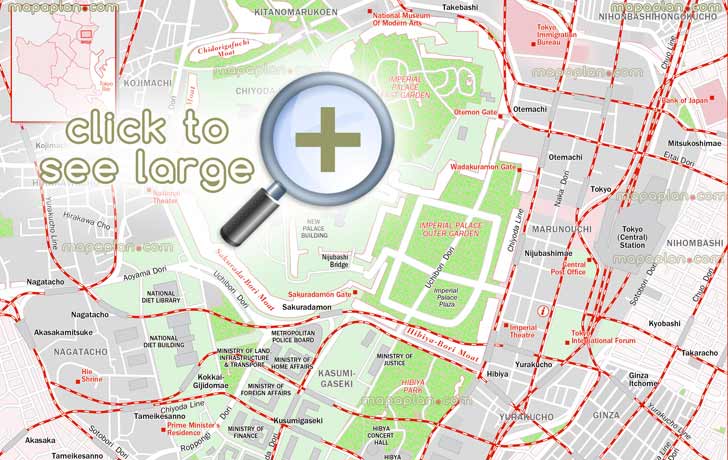
You can view, download or print a full, high resolution (detailed, large) version of this image by clicking on the plan itself
Asakusa metro train line station walking trip tour itinerary planner showing Asakusa Shrine, Sensoji Temple, Hozomon Gate, Dempoin Temple, Five-Story Pagoda, shopping arcades, Nitemmon Gate, Amuse Museum - Tokyo top tourist attractions map
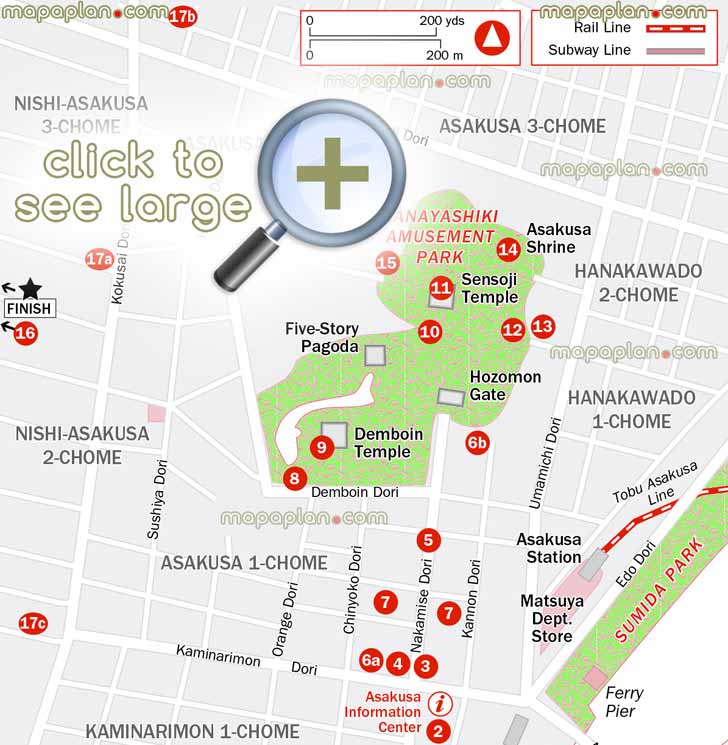
You can view, download or print a full, high resolution (detailed, large) version of this image by clicking on the plan itself
Harajuku train station & Aoyama landmarks finder urban walking trail covering Meiji Jingu Shrine, Takeshita Dori Street, Oriental Bazaar, Omotesando Hills, Nezu Museum, Taro Okamoto Memorial Museum, Meiji-Jingumae & Omotesando stations - Tokyo top tourist attractions map
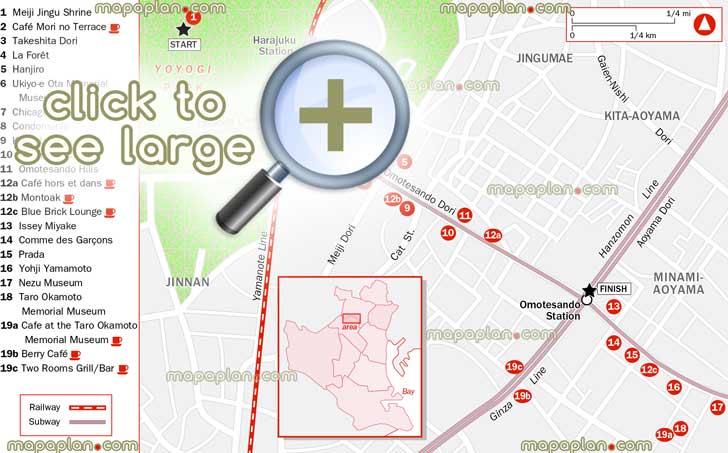
You can view, download or print a full, high resolution (detailed, large) version of this image by clicking on the plan itself
Ueno Park & Zoo local walking tour map with Keisei Ueno subway train station, tombs, Toshogu Shrine, Shinobazu Pond, Ameyoko Market shopping, National Museum of Nature and Science - Tokyo top tourist attractions map
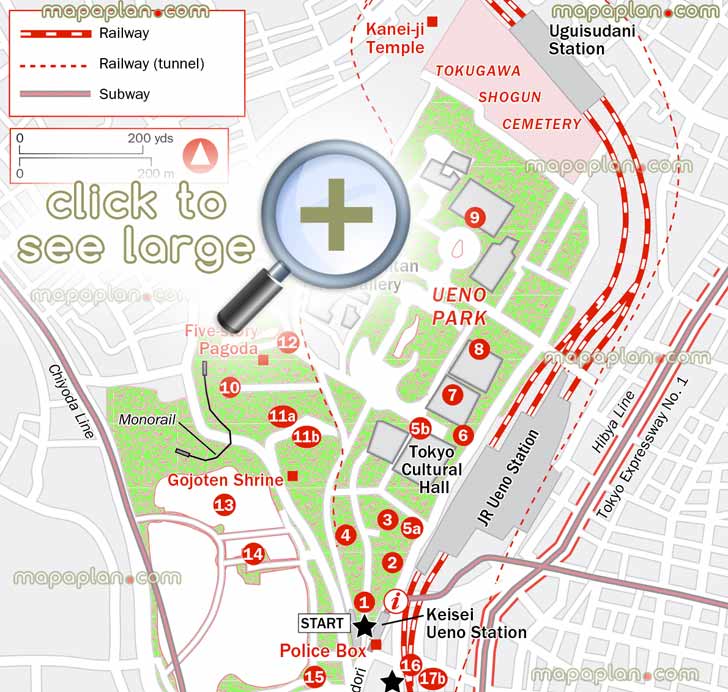
You can view, download or print a full, high resolution (detailed, large) version of this image by clicking on the plan itself
Yanaka region walking tour directions map with Nippori train station, Fabric Town, Tennoji Temple, Choanji Temple, Yanaka Cemetery - Tokyo top tourist attractions map
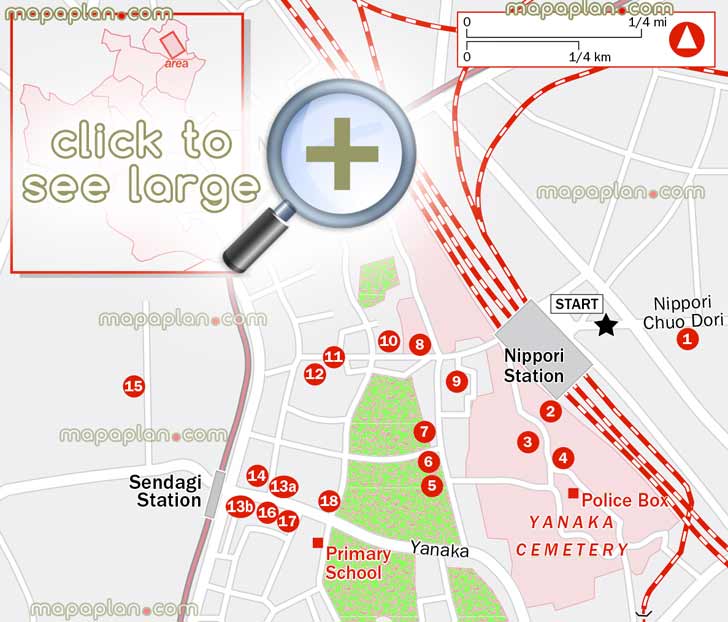
You can view, download or print a full, high resolution (detailed, large) version of this image by clicking on the plan itself
3 day trip - day 1 - Virtual explorer guide to Tokyo in Japan - Whole day sightseeing tour covering must-see places including Tsukiji Fish Market, Hama Rikyu Garden, Sumida River Boat Cruise, Nakamise Dori, Sensoji Temple, National Museum in Ueno, Ginza - Tokyo top tourist attractions map

You can view, download or print a full, high resolution (detailed, large) version of this image by clicking on the plan itself
3 day trip - day 2 - Tour covering major points of interest such as Edo-Tokyo Museum near Ryogoku metro train station, Akihabara, Harajuku, Oriental Bazaar market, Meiji Jingu Shrine, Shinjuku, Observatory - Tokyo top tourist attractions map
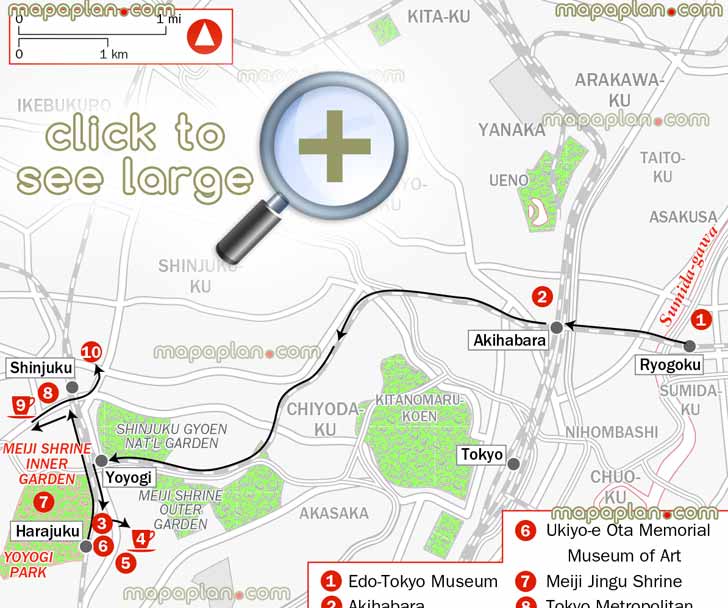
You can view, download or print a full, high resolution (detailed, large) version of this image by clicking on the plan itself
3 day trip - day 3 - Light rail train (LRT) to Kamakura beach suburb beyond Greater Tokyo to see Komachi Dori Street, Yumigahama Beach, Sagami Bay, Hase Kannon Temple, Great Buddha - Tokyo top tourist attractions map
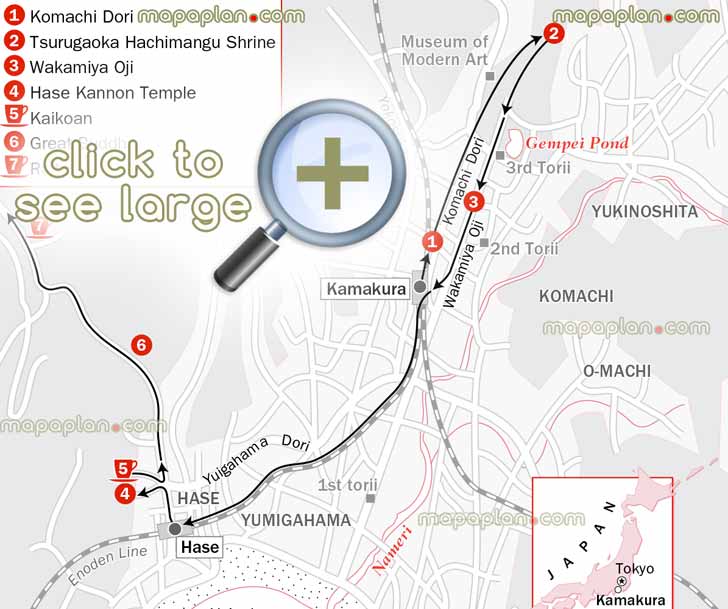
You can view, download or print a full, high resolution (detailed, large) version of this image by clicking on the plan itself
Point and speak funny bilingual English & Japanese legend poster map with updated plan of station zoning area & exits - Nihonbashi Bridge, Imperial Palace Detached Court, Wadakura Fountain Park, Hibiya Park, Mutsukoshi, Takashimaya, Matsuya Department Store, Mitsukoshi, Sony Building, Hato Bus Stop, Main JR Station - Tokyo top tourist attractions map
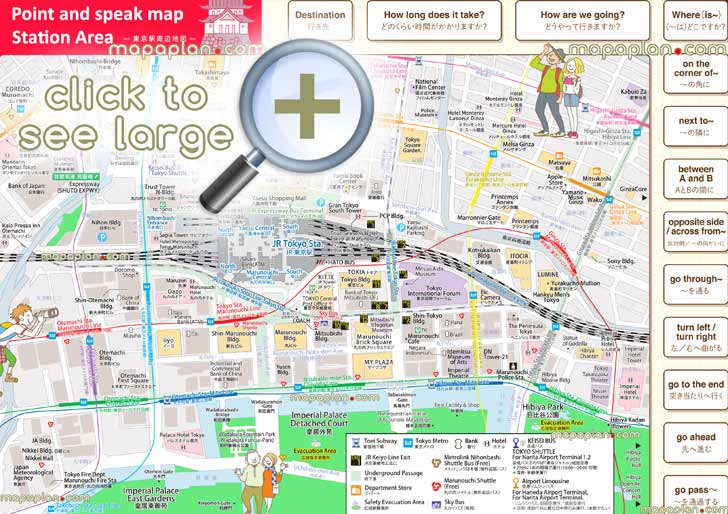
You can view, download or print a full, high resolution (detailed, large) version of this image by clicking on the plan itself
Map of top 10 attractions in Tokyo
The typical top ten attractions are listed below. You can find the detailed locations of these places on the maps above.
- Imperial Palace Grounds - Part 'Forbidden City,' part public park, the palace grounds are encircled by moats, stone walls, ancient bridges, keeps, and gardens (e.g. Imperial East Gardens) – elements in the history of the original city.
- Senso-ji Temple - The grounds of this fascinating temple are packed with attractions, which begin at the Thunder Gate and the commercial corridor of Nakamise.
- Sumida River Buses - An excursion starting under the Sumida River famous bridge is a journey through the history and development of the city. Cruise down the Sumida-gawa or across Tokyo Bay on one of the city's river buses, including the manga-inspired Himiko sightseeing boat.
- Edo-Tokyo Museum - Blending history, art, and architecture, this stupendous museum traces the history of the city from Edo Castle to the Tokyo Olympics.
- Ueno Park - A compendium of Japanese cultural history, this extensive park contains temples, mausoleums, major museums, a zoo, and a splendid lotus pond. With its 1,000 cherry trees, the park serves as a great picnic spot in spring.
- Tokyo National Museum - The world's largest collection of Japanese art and archeology plus Chinese, Korean, and Central Asian art treasures are housed here.
- Koishikawa Korakuen Garden - Tokyo's oldest garden has a heart shaped pond, lacquered wood and stone bridges, rock arrangements, islands, miniature hills, and a lotus pond – all rife with symbolism.
- Meiji Shrine - At a center of a forest, the exquisite Shinto architecture of shrine buildings and a beautiful iris garden embody the theme of nature.
- Yanaka Cemetery - Ghosts of old Edo linger here among the gnarled cherry trees and mouldering tombs of shoguns, warriors, writers, and Kabuki actors.
- Odaiba Island - Featuring high-tech buildings, exhibition sites, museums, fashion malls, a giant Ferris wheel, and a man-made beach, the artificial island of Odaiba is both entertainment and experiment.
- Other popular places to visit in greater Tokyo & surrounding zones include:
- Asakusa - The city's most colourful and evocative district, home to old craft shops, traditional inns, restaurants and the bustling Sensō-ji temple.
- Rikugien - A quintessential Japanese-style garden designed to reflect scenes from ancient Japanese poetry.
- Shinjuku - From the rarified heights of the Park Hyatt's New York Bar to the tiny drinking dens of Golden Gai and the gay district of Ni-chōme, Shinjuku has a bar for you.
- Happo-en Garden - Sip 'matcha' (thick green tea) in one of Tokyo's loveliest traditional gardens.
- Shinjuku Gyoen - Japanese, English and French styles of landscape gardening combine in delightful Shinjuku Gyoen.
- National Art Centre - Set aside a chunk of time to explore this enormous new gallery, the highlight of the so-called Roppongi art triangle.
- Onsen bath - Soak your stresses away in an old neighbourhood bathhouse such as the Azabu-Jūban Onsen or the resort-like spa complex of Ōedo Onsen Monogatari in Odaiba.
- Harajuku - Pick through the Sunday flea market at Togo-jinja and trawl the funky backstreet boutiques and galleries.
- Rainbow Bridge - Walk across this elegant, 918-metre-long.suspension bridge for fabulous views across Tokyo Harbour towards the futuristic mini-city of Odaiba.
- Tsukiji Fish Market - Get up early to see the nation's top fish market and to enjoy a fresh sushi breakfast.
- Naka-Meguro - Discover some of the city's coolest boutiques, cafés, restaurants and bars along the tranquil banks of the Meguro River.
- Kabuki - Enjoy the liveliest of Japan's traditional performing arts at the grand Kabuki-za theatre in Ginza.
- Yurakucho - Join off-duty salarymen over a beer and a plate of yakitori (small meat kebabs) at the many raucous joints beneath the railway tracks in this part of town.
- Nikko - This dazzling Toshogu shrine is the star turn of this mountain town, which also boasts some of the most beautiful countryside in Japan.
- Hanami parties - Unpack your bentō and sake in Ueno Park or around the Imperial Palace moat for a picnic under the falling blossoms.
- Meiji-jingu - Enjoy one of the many annual festivals or regular wedding ceremonies held at Tokyo's most venerable Shinto shrine.
- Sumo - Witness the titanic clashes of sumo giants at the Ryogoku National Stadium in Ryogoku. Don't miss the free Sumo Museum in the Ryogoku Kokugikan when you are in the area.
- Yanaka - Charming old fashioned district crammed with small temples and wooden houses on twisting byways.
- Disneyland & DisneySea - Tokyo Disney Resort comprises two separate but adjacent attractions: Tokyo Disneyland, a close copy of the Californian original, and DisneySea Park, a water- and world-travel-themed area. This unashamed slice of Americana, situated in east of the city centre, may not be what you came to Japan for, but you will probably want to visit these if you are travelling with children.
- Additionally if you have sufficient time you can also visit Kappabashi Street, Happo-en Garden, Ameyoko Market, Kagurazaka, Yebisu Garden Place beer / brewery museum near the Ebisu Station, Kyu Shiba Rikyu Garden, Shinjuku Golden Gai, the former Edo Castle in Chiyoda, Japan National Tourist Organization (JNTO).
What are some interesting facts about Tokyo?
Tokyo has been the capital of Japan only since 1868; before that, Kyoto served as capital for more than 1,000 years.
Ten percent of Japan's total population lives in Tokyo—more than 13 million residents. Almost a quarter of Japan's total population lives within commuting distance.
Tokyo's workers commute to work an average of 90 minutes one-way. Shinjuku Station handles the most train and subway passengers in all of Japan—more than 3.6 million people a day, giving it an entry in the Guinness Book of World Records as the busiest rail station in the world. More than 200 exits, including those from surrounding underground shopping passages and shopping centers, lead out of the station.
Mount Fuji is visible from Tokyo about 80 days a year, mostly in winter.
Tokyo suffered widespread destruction twice in the last century—in the 1923 Great Kanto Earthquake and from World War II firebombs. In both instances, more than 100,000 people lost their lives. The 2011 Great East Japan Earthquake left Tokyo relatively unscathed.
During the Edo Period (1603– 1867), Edo (old Tokyo) witnessed almost 100 major fires, not to mention countless smaller fires.
Tokyo sprawls over 1,288 sq. km (497 sq. miles), yet most streets are not named.
Rickshaws originated in Tokyo in 1869; 4 years later, there were 34,000 of the people-propelled vehicles in the capital city.
Green space in Tokyo is woefully inadequate—just 4.52 sq. m (51⁄2 sq. yd.) per capita, compared to 45.7 sq. m (55 sq. yd.) in Washington, D.C.
The yakuza (members of Japan's mobster underworld) were barred from participating in construction of the Tokyo Sky Tree in an effort to undermine the gangsters' cozy relationship with construction companies in Japan. According to police information, it's estimated that almost 83,000 gangsters belonging to 23 crime syndicates across the country generate an economy worth 20 trillion yen.
The yakuza (members of Japan's mobster underworld) were barred from participating in construction of the Tokyo Sky Tree in an effort to undermine the gangsters' cozy relationship with construction companies in Japan. According to police information, it's estimated that almost 83,000 gangsters belonging to 23 crime syndicates across the country generate an economy worth 20 trillion yen.
How can I find specific tourist attractions on the map of Tokyo?
Our interactive city maps are easy to explore. You can pan, zoom in, and zoom out on the high-resolution map to locate major tourist attractions. Each map highlights key landmarks, making it simple to find the sights you're most interested in, whether it's a famous monument, museum, or other point of interest.
Can I get a visual representation of the area around Tokyo?
For some cities, we provide a general view of the area surrounding popular attractions. While this image won't show the exact street-level view, it helps you understand the layout of the neighborhood, showing how the landmarks are situated in relation to other points of interest around Tokyo.
Can I explore maps for both tourist attractions and other points of interest?
Yes! Our platform offers maps covering a range of highlights, from top tourist attractions to other noteworthy areas such as parks, restaurants, and entertainment venues. Whether you're planning a visit to a museum or looking for a nearby park, our detailed maps make it easy to find the best spots in the city.
Related keywords
2023, 2024, 2025, 2025, 2026, 2027, 2028, 2029, map, plan, download, print, printable, free, detailed, aerial, bird's eye, satellite, guide, planner, travel, sightseeing, visit, trip, tour, tourist, what to do, where to go, things to do, must see, top attractions, points of interest, places, sites, sights, buildings, spots, destinations, locations, landmark, museum, in a week, in 3 days, one day, city, route, bus, kids, children, top 10, top ten, popular, famous, interesting, highlights, public transport, rail, hotels, updated, metro, subway, underground, tube, downtown, coach, nightlife, pub, monument, satellite, accommodation, transit, transportation, supermarket, children, metro, subway, underground, tube